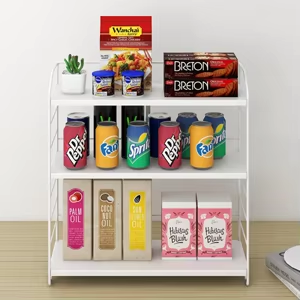잦은 사용에 적합한 최고의 조리대 스파이스 랙을 만드는 데 어떤 소재가 가장 좋은가요?
내구성 있는 주방 정리 솔루션을 위한 필수 소재
모든 주방의 핵심은 정리에 있으며 카운터탑 스파이스 랙 효율적인 조리 공간을 만드는 데 중요한 역할을 합니다. 전문 셰프이신지, 아니면 열정적인 집 요리사이신지에 관계없이, 스파이스 보관 솔루션에 적합한 소재를 선택하는 것은 제품의 수명과 기능성에 큰 영향을 미칩니다. 다양한 소재들이 일상적인 사용에도 견딜 수 있고, 향신료를 항상 손쉽게 꺼낼 수 있도록 유지하는 방법에 대해 알아보겠습니다.
오래 사용할 수 있는 스파이스 보관을 위한 프리미엄 소재 옵션
스테인리스 스틸: 전문가의 선택
스테인리스 스틸 카운터 상판용 스파이스 랙은 내구성과 청결성의 표준을 나타냅니다. 이 소재는 녹, 부식 및 일상적인 마모에 매우 강해 바쁜 주방 환경에 이상적입니다. 전문가급 스테인리스 스틸 랙은 자주 청소하고 온도 변화와 실수로 부딪히는 상황에도 손상된 흔 없이 견딜 수 있습니다. 세련되고 모던한 외관은 어떤 주방 인테리어에도 잘 어울리며 필수 조미료를 안정적으로 보관할 수 있는 공간을 제공합니다.
스테인리스 스틸의 비다공성 특성은 박테리아 번식을 방지하며 청소를 매우 간편하게 만들어 줍니다. 고급형 카운터 상판용 스파이스 랙의 경우 브러시드 또는 폴리시드 마감 처리를 통해 지문이 묻기 어렵고 빈번한 사용 후에도 외관을 오랫동안 유지할 수 있습니다. 이 소재가 지닌 본연의 강도 덕분에 저장 공간을 극대화하면서도 조리대 공간 사용을 최소화하는 혁신적인 디자인이 가능합니다.
단단한 원목: 전통적인 우아함과 기능성의 조화
단단한 나무 상판 스파이스 랙은 주방에 따뜻함과 자연스러운 아름다움을 더해주며 뛰어난 내구성도 제공합니다. 오크, 단풍나무, 대나무와 같은 소재는 자연적인 항균 특성을 지니고 있어 적절히 관리할 경우 수년간 사용할 수 있습니다. 단단한 나무의 가장 큰 장점은 충격을 완충하여 손상 없이 견딜 수 있다는 점이며, 더 딱딱한 소재들과는 달리 파손 위험이 적습니다.
오랜 수명을 보장하려면 수분과 흘림에 대비해 식품 안전 코팅 처리가 된 단단한 나무 스파이스 랙을 선택하세요. 천연 나뭇결 무늬는 시각적 매력을 더해주며 일상 사용 중 생길 수 있는 작은 흠집도 잘 가려줍니다. 고급 단단한 나무 랙은 강화된 이음매와 안정적인 받침대를 갖추어 완전히 가득 찼을 때에도 전복되지 않도록 설계된 경우가 많습니다.
현대적 주방을 위한 현대 합성 소재
고급 아크릴: 가볍지만 튼튼함
현대적인 아크릴 카운터톱 스파이스 랙은 가벼운 두께를 유지하면서도 뛰어난 투명성과 충격 저항성을 제공합니다. 고품질 아크릴 소재는 주방 환경에 장기간 노출되더라도 변색을 방지하고 투명도를 유지합니다. 아크릴의 다용도성 덕분에 혁신적인 디자인이 가능해 스파이스 컬렉션을 멋지게 전시하면서 먼지와 습기로부터 보호할 수 있습니다.
휨을 방지하고 안정성을 보장하는 두꺼운 벽면의 아크릴 구조 제품을 선택하세요. 고품질 아크릴 랙은 자외선 저항 기능을 갖추고 있어 일반 주방 청소제로 반복 세척하더라도 흐려지거나 손상되지 않습니다. 이 소재는 얼룩에 자연스럽게 강하기 때문에 색이 선명한 스파이스를 보관할 때 생길 수 있는 자국에도 특히 적합합니다.
강화 대나무 복합재: 친환경적 내구성
대나무 복합 소재의 조리대 양념통 선반은 내구성을 희생하지 않으면서도 환경을 고려한 선택입니다. 이 소재는 천연 대나무 섬유와 식품 안전성 레진을 결합하여 안정적이고 습기에 강한 양념 보관용 플랫폼을 만듭니다. 결과적으로 나온 제품은 전통적인 목재보다 우수한 강도를 제공하면서도 자연스러운 외관을 유지합니다.
대나무 복합 소재의 조밀한 구조는 긁힘과 마모에 강해 주방에서 자주 사용하는 공간에 이상적입니다. 이러한 선반은 시간이 지나도 안정성을 높이고 분리되는 것을 방지하는 혁신적인 접합 디자인을 갖춘 경우가 많습니다. 이 소재는 습도 변화에 대한 자연스러운 저항력을 가지므로 수분에 민감한 양념 보관에 특히 적합합니다.

소재 선택 시 고려사항
환경 영향 및 지속 가능성
조리대 양념통 선반의 소재를 선택할 때는 환경적 영향을 고려해야 합니다. 대나무나 재활용 스테인리스강 같은 지속 가능한 옵션은 뛰어난 내구성을 제공하면서 생태계에 미치는 영향을 최소화합니다. 확인해보세요. 제품 환경 단체 및 책임감 있는 조달과 생산 방법을 우선시하는 제조업체에 의해 인증됨.
최근의 많은 소재들은 강도나 외관을 희생하지 않고도 재활용 성분을 포함하고 있습니다. 제품의 전체 수명 주기를 고려하세요. 향후 재활용 가능성이나 생분해 가능성도 함께 생각해야 합니다. 지속 가능한 소재는 종종 주방 공간 내 공기질 개선이라는 추가적인 이점을 제공합니다.
유지 보수 요구 사항 및 수명
다양한 소재는 그 외관과 기능성을 유지하기 위해 서로 다른 수준의 관리가 필요로 합니다. 스테인리스 스틸과 아크릴은 일반적인 청소 외에 거의 추가 관리가 필요 없는 반면, 목재 소재는 습기 손상을 방지하기 위해 가끔씩 재도장이나 코팅 처리가 필요할 수 있습니다. 소재를 선택할 때 본인이 투자할 수 있는 시간과 유지 관리 작업을 수행하려는 의지를 고려하세요.
고품질 소재에 대한 투자는 제품 수명 연장과 교체 비용 절감을 통해 종종 이익을 가져옵니다. 내구성 있는 소재로 제작된 프리미엄 카운터탑 스파이스 랙은 매일 사용하더라도 수년간 기능성과 외관을 유지하여 진지한 요리사들에게 경제적인 선택이 됩니다.
자주 묻는 질문
다양한 소재가 스파이스의 신선도에 어떤 영향을 미칩니까?
스테인리스강 및 밀봉된 단단한 나무와 같은 소재는 빛과 습기로부터 우수한 보호 기능을 제공하여 스파이스의 신선도를 유지하는 데 도움이 됩니다. 아크릴 및 대나무 복합 소재 또한 밀폐 기능과 자외선 저항 특성을 적절히 설계했을 경우 좋은 보호 효과를 제공합니다.
어떤 소재가 청소와 관리가 가장 쉬운가요?
스테인리스강과 고급 아크릴 소재는 일반적으로 청소와 관리가 가장 쉽습니다. 이 소재들은 얼룩이 잘 생기지 않고 냄새를 흡수하지 않으며, 특별한 처리 없이도 일반 주방 청소제로 쉽게 닦아낼 수 있습니다.
습한 환경에서 가장 효과적인 소재는 무엇입니까?
스테인리스강과 적절히 밀봉된 대나무 복합 소재는 습한 환경에서 뛰어난 성능을 발휘합니다. 이러한 소재는 휘거나 습기에 의한 손상에 강해, 주방이라는 열악한 조건에서도 구조적 무결성을 유지합니다.

 EN
EN
 AR
AR
 BG
BG
 HR
HR
 CS
CS
 DA
DA
 NL
NL
 FI
FI
 FR
FR
 DE
DE
 EL
EL
 HI
HI
 IT
IT
 JA
JA
 KO
KO
 NO
NO
 PL
PL
 PT
PT
 RO
RO
 RU
RU
 ES
ES
 SV
SV
 CA
CA
 TL
TL
 IW
IW
 ID
ID
 LT
LT
 SR
SR
 SK
SK
 SL
SL
 UK
UK
 VI
VI
 HU
HU
 TR
TR
 AF
AF
 MS
MS
 GA
GA
 LA
LA
 MN
MN



